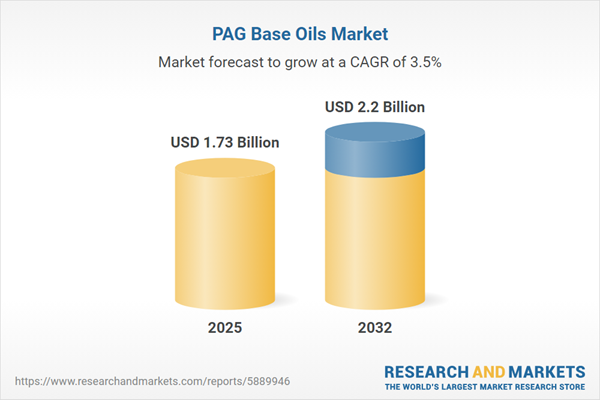Speak directly to the analyst to clarify any post sales queries you may have.
Senior executives in the lubricant and specialty chemicals industries are confronting a period of accelerated transformation, with the polyalkylene glycol base oils market poised to unlock new opportunities for high-performance and sustainable lubrication solutions.
Market Snapshot: Polyalkylene Glycol Base Oils Market
The Polyalkylene Glycol (PAG) Base Oils Market grew from USD 1.67 billion in 2024 to USD 1.73 billion in 2025. With a CAGR of 3.48%, it is projected to reach USD 2.20 billion by 2032. This upward trend reflects the sector’s response to evolving regulatory frameworks, demand for advanced lubrication technologies, and expansion into sectors that require efficient, environmentally responsible solutions.
Scope & Segmentation
This market research report offers a comprehensive analysis of the PAG base oils landscape, structured as follows:
- End Use: Automotive lubricants, grease formulations, industrial lubricants, and metalworking fluids.
- Viscosity Grade: 100 to 300 Cst, above 300 Cst, and below 100 Cst options for diverse applications.
- Product Type: Diols, polyethers, and triols, each presenting tailored performance characteristics.
- Sales Channel: Direct sales, chemical distributors, and lubricant blenders.
- Geographical Coverage: Americas (including North America and Latin America), Europe, Middle East & Africa, and Asia-Pacific regions.
- Key Companies: The Dow Chemical Company, BASF SE, Evonik Industries AG, Solvay SA, Eastman Chemical Company, The Lubrizol Corporation, Huntsman International LLC, INEOS Group Limited, Mitsubishi Chemical Corporation, Clariant AG.
Technological and Regional Landscape
- Technologies Monitored: Continuous process innovation, enhanced catalysis, digital lubricant monitoring, and advanced additive packages.
- Regional Dynamics: Growth driven by mature automotive and industrial sectors in the Americas, regulatory-led product development in Europe, rapid adoption in Asia-Pacific due to increasing manufacturing, and infrastructure expansion in the Middle East and Africa.
Key Takeaways for Senior Decision-Makers in the PAG Base Oils Market
- Shifts toward sustainable formulations are accelerating adoption in automotive, industrial, and metalworking applications, driven by stringent regulatory frameworks.
- Electrification and e-mobility are introducing fresh requirements for lubricants, emphasizing dielectric properties, low volatility, and thermal stability as base selection criteria.
- R&D collaboration with additive developers and equipment manufacturers is becoming central to commercial differentiation amid tightening performance specifications.
- Real-time fluid monitoring and predictive analytics are supporting proactive lifecycle management, optimizing supply chains, and fostering more responsive procurement strategies.
- Flexible portfolio management, including localizing production capabilities and aligning with circular economy principles, is enabling market participants to address diverse customer requirements effectively.
Tariff Impact Analysis
Revised United States tariffs introduced in 2025 have led to shifts in sourcing, logistics, and supplier negotiation strategies across the global polyalkylene glycol market. Increased landed costs are prompting buyers to explore regional supply alternatives and invest in local production. These trade developments are requiring a balance between cost control, product substitution, and the retention of equipment reliability and environmental compliance. Both global and regional players are adjusting procurement frameworks to remain competitive in a more complex international landscape.
Methodology & Data Sources
This report integrates a dual approach, combining comprehensive primary interviews with industry executives and structured surveys, complemented by robust secondary research from regulatory archives, intellectual property records, and sector-specific publications. Data triangulation and best-practice analytical frameworks ensure both qualitative depth and quantitative accuracy.
Why This Report Matters to Executive Leadership
- Gain clarity on emerging opportunities and challenges in supply chain management, innovation, and compliance to inform strategic planning.
- Benchmark against leading players’ strategies in technology, partnerships, and portfolio expansion to support sustainable growth initiatives.
- Equip your organization with actionable insights on regulatory, sourcing, and product trends for optimum market positioning.
Conclusion
The polyalkylene glycol base oils market is moving toward greater integration of performance-focused innovation and sustainability practices. Stakeholders poised to align portfolios, invest in technological advancement, and adapt to evolving global trade dynamics are best positioned for resilient growth and compliance-driven leadership.
Additional Product Information:
- Purchase of this report includes 1 year online access with quarterly updates.
- This report can be updated on request. Please contact our Customer Experience team using the Ask a Question widget on our website.
Table of Contents
3. Executive Summary
4. Market Overview
7. Cumulative Impact of Artificial Intelligence 2025
Companies Mentioned
The companies profiled in this PAG Base Oils market report include:- The Dow Chemical Company
- BASF SE
- Evonik Industries AG
- Solvay SA
- Eastman Chemical Company
- The Lubrizol Corporation
- Huntsman International LLC
- INEOS Group Limited
- Mitsubishi Chemical Corporation
- Clariant AG
Table Information
| Report Attribute | Details |
|---|---|
| No. of Pages | 180 |
| Published | October 2025 |
| Forecast Period | 2025 - 2032 |
| Estimated Market Value ( USD | $ 1.73 Billion |
| Forecasted Market Value ( USD | $ 2.2 Billion |
| Compound Annual Growth Rate | 3.4% |
| Regions Covered | Global |
| No. of Companies Mentioned | 11 |









